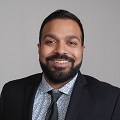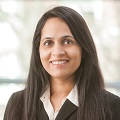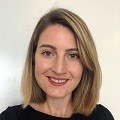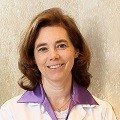An Interview with Madhuri Are, MD, Division Chief of Pain Medicine at University of Nebraska’s Department of Anesthesiology
 Rohit Nalamasu, DO
Rohit Nalamasu, DO
PGY3, University of Nebraska Medical Center College of Medicine PM&R Program

University of Nebraska Medical Center College of Medicine
Division Chief of Pain Medicine, Department of Anesthesiology
Director of Cancer Pain Management
Dr. Nalamasu: First off, thank you Dr. Are for taking time out of your busy day to speak with me.
Dr. Are: Things are certainly crazy, and I am wishing we could return to the regular old days. Happy to make the time to talk.
Dr. Nalamasu: What drew you to Physical Medicine and Rehabilitation, and then Pain Medicine?
Dr. Are: What drew me to both my primary specialty and subspecialty was that I felt that I could help the patient by improving their quality of life and their functionality. That was very rewarding for me from a PM&R standpoint. Spending time with patients and their families was also rewarding to me. These qualities all trickled over into Pain Medicine, and I feel that I am still able to improve patient function and have a relationship with them and their families through interventional techniques and medication management. I see this especially in my cancer pain patients, where I see a significant improvement in their overall functionality and quality of life.
Dr. Nalamasu: What do you think your training in Rehabilitation Medicine has brought to your specific practice?
Dr. Are: I see the patient as a whole person and I take into account external factors that affect their daily lives. In the setting of chronic back or neck pain, I always question how they are going to complete their activities of daily living (ADLs), how they are going to take care of their kids. This is important because when we are talking about medication management, we are talking about potentially sedating medications. I usually ask if the patient has kids or obligations that they would need to take care of that the medication may impede. I feel my training in PM&R has given me a broader perspective in terms of the patient’s life outside of their diagnosis.
Dr. Nalamasu: I certainly saw that too while rotating with you, especially with the cancer pain patients, where a lot of questions that were asked were things that were related to their life outside of medicine that are still applicable, but maybe not thought of initially.
Being both a female and a physiatry-trained division chief of an anesthesia-based department makes you a role model for a lot of physiatrists in-training. What can you tell us about your path here?
Dr. Are: Part of my style is developing a rapport with the patient, getting to know them as people and not just getting focused on the procedure or their pain. I think that this helped me in being able to have the special bond and relationship with patients that may not be as present in other specialties, where they may be more trained in just doing the procedure or writing the script. I think that my background and training helped me develop those relationships and bonds – not just with patients, but also with other departments as well. I feel that I can get along well with people in other departments, even though we may disagree on some things. Collaboration is important to me, and I like bringing everyone to the table and try to work together and support each other. I believe this goes a long way. Being a team player and building bridges gives you more opportunity to advance; people want to work with you. The question that’s important to ask yourself is, would you want to work with someone like yourself?
Dr. Nalamasu: Certainly, I can see how being collaborative and respectful benefits you in leading a division. Considering all the people you've met in your field, what personal attributes do you think are essential for success?
Dr. Are: Part of the factors for success for me would be being a good mentor and being supportive of your colleagues, both in your department and others. Also, being accessible and available to people. Let them know that you are here to help them and that they can count on you.
Dr. Nalamasu: What do you find most enjoyable about your job? What are the toughest parts of your job?
Dr. Are: The most enjoyable part of my job is when you can make a difference in that patient’s quality of life. Some of our patients may have had to deal with pain and immobility for so long, and suddenly we do an intervention that may be simple in our mind, but for them makes a world of difference. This is especially true in our oncology pain patients at end-of-life. While we may not be able to change the inevitable, we can change their outlook on it and provide them with quality time over their last few weeks or months. When that happens, I feel like I’ve done something good for them.
The toughest parts of my job are when you are working with members of other departments or teams. While everyone respects each other and are really good friends, it is tough when there are disagreements on how to handle certain situations. However, at the end of the day, we all respect each other and are able to work through those disagreements towards a common goal. That mutual respect is vital to overcoming any disagreement.
Dr. Nalamasu: Both you and your husband are both very involved as physicians in the University of Nebraska system, but also both have a plethora of non-clinical and clinical obligations for the university. This is amplified now with the COVID-19 pandemic. How do you both maintain a work-life balance?
Dr. Are: The way that we balance our work-life issues is that we try not to have our initial conversation after our workday be about work, no matter of how bad the situation or how frustrated we are. To me, when that happens, it means that you are automatically starting off the interaction on the wrong foot with someone that you haven’t seen since the night before. To me, when you greet someone, it should really be a greeting, not a venting session. Looking at things in the perspective of your significant other is also important, and often they could have had an even worse day.
The other thing is that we are good at checking our email on a constant basis, even though we try not to in the evening or when taking care of the kids. This helps us communicate quicker with our colleagues. Sometimes the biggest thing is really being communicative with the family, making sure that they understand that sometimes you may have something important to do, but that doesn’t necessarily downplay what they have going on their plate. It’s important to draw strong boundaries between home and work, although it’s impossible to truly separate them. It’s certainly hard when work means seeing your significant other less, but that makes it more important to spend the time together as positive time where you reflect on each other.
Dr. Nalamasu: That’s good advice for someone like me, with a physician wife in the same field, or even just two-physician households in general.
Being a resident working with you and the pain medicine department, I’ve been privileged to be exposed to the strong female leadership within the University of Nebraska system, especially in traditionally male-dominated fields like Anesthesia and Pain Medicine. In fact, recent data shows women make up only around 20% of pain physicians, despite making up 50% of medical students.[1] What advice would you give to female residents and medical students who are hoping to go into Pain Medicine?
Dr. Are: I think the first piece of advice I would give is that women should keep their options open. I think that a lot of times, the first thing that many female medical students think of is about the future, and the quality of life that a specialty would give if they get married and have kids. I would say that Pain Medicine fits this lifestyle, but it’s important to pick your priorities and keep that boundary between work and home. To those hoping to pursue pain fellowship, I would tell them that they can do it, and an advantage is that you can make your practice in Pain Medicine as family friendly as you want or not. There is a real advantage in the ability to mold a pain practice to the individual’s needs, part-time or full-time. Certainly, this flexibility was something attractive to me. The flexibility also applies to the individual’s practice. One can focus on suboxone patients, cancer pain patients, bread and butter procedures. Women should keep their options open.
Dr. Nalamasu: I know that a large part of your clinic practice involves cancer pain. What brought you down that path, and given the increasing importance of rehabilitation in cancer treatment, do you see more physiatry involvement in the field?
Dr. Are: Interestingly, I would say it happened by chance. I happened to be in Houston, TX, where I did a one-month rotation at the University of Texas MD Anderson Cancer Center, at the recommendation of one of my senior residents. When I rotated through there, I was amazed, and maybe had a skewed initial exposure to Pain Medicine, based on the amount of cancer pain patients we saw. I really enjoyed seeing those patients, and I felt that my background and primary specialty helped me really connect with these patients. I enjoyed spending extra time with those patients, especially on consults and initial visits. It really turned out well, and the patients were more comfortable throughout the process. I found that this made a significant difference. Seeing the improvement in their quality of life was something really attractive to me. There are tough parts as well. Nobody wants to go home knowing that patient younger than them just passed. Those are days that you will never forget, especially when hearing family members talk about losing their loved ones. I’m grateful that often, I am able to allow the family time to be with their loved ones without the nausea, constipation, or side effects of opioids. I really enjoy my part in allowing the patient to enjoy those family gatherings or events, and it makes me realize how appreciative I am for what I have.
Dr. Nalamasu: That’s amazing and really touching. I think in this time, it benefits us all to remember how grateful we need to be for our loved ones.
Speaking of oncology patients, at rehabilitation hospitals like ours, we are seeing an increasing presence of oncological and medically complex patients. Do you see more physiatry involvement in oncological care in your experience, compared to when you began practicing?
Dr. Are: I think there probably will be, as far as the needs go. These patients are living longer, as these oncological diagnoses are becoming chronic illnesses rather than terminal illnesses. We’ve seen this in breast cancer, rectal cancer, and colon cancer. I think there will continue to be a larger role of physiatry for these patients, to aid in their functional improvement.
Dr. Nalamasu: We are privileged to have the Buffet Cancer Center here at the University of Nebraska Medical Center and have a medically complex unit at Madonna Rehabilitation Hospital – Omaha. With the management of cancer and medically complex patients becoming more common in our field, we are grateful to have providers like you and your colleagues in the system to benefit our community.
Thank you so much for taking the time to talk to me, Dr. Are.
References:
[1] Doshi TL, Bicket MC. Why Aren't There More Female Pain Medicine Physicians?. Reg Anesth Pain Med. 2018;43(5):516-520. doi:10.1097/AAP.0000000000000774
An Interview with Heidi Prather, DO, Washington University PM&R Division Chief and Department of Orthopedic Surgery Vice Chair

Alexandra E.C. Fogarty, MD
PGY-2, Washington University/B-JH/SLCH Consortium PM&R Program

Heidi Prather, DO, FAAPMR
Professor & Division Chief, Physical Medicine and Rehabilitation
Washington University School of Medicine
Introduce yourself.
I'm Heidi Prather and I'm a Physical Medicine & Rehabilitation specialist at Washington University School of Medicine. I’m originally from the Midwest, and have stayed in the Midwest most of my career. I grew up in Kansas City, Missouri.
I trained in PM&R at Northwestern University and practiced there for 3 years. I came to Washington University School of Medicine following my husband here, and once here, I was able to develop a Musculoskeletal Division in the Department of Orthopedic Surgery.
What do you do outside of work?
I have two children that are now in college. Throughout a good portion of my career life, my interests were related to their interests, which was great. My interests on my own, as an empty nester, are that I love to hike and run, and I enjoy reading. I am married to a physician. I’m married to radiation oncologist Jeffrey D. Bradley, MD, FACR, FASTRO [now at Emory University]. Being married to a physician leader presents its own unique challenges as well.
What's your present role within the department of Orthopedics?
I'm currently vice chair of the Department of Orthopedic Surgery. I'm division chief of Physical Medicine and Rehabilitation, which I founded here at Washington University. I am the medical director of the new Barnes Jewish West County Joint & Spine Center and founder of the Living Well Center.
It sounds like you have many active projects at the moment! What are your main research interests?
My main research interest is providing evidence for important links that providers should notice in their patients. Those links help you figure out how to help somebody best, either treatment-wise, or cope with a chronic problem, or overcome an injury. That's manifested itself in several ways in the literature that I have been able to publish.
I started with posterior pelvic girdle as an interest. That was an interest that was facilitated by a mentor, Michael Geraci, Jr., MD, PT, FAAPMR. I got to spend time with him in his practice in Buffalo, NY, in December of my PGY-4 year. That's how dedicated I was—Buffalo in December!
He's the one who introduced me to the work of Andry Vleeming, PhD, and my interests took off from there. A lot of good work was done on the intricacies of the pelvis, but more work was needed to show the complicated connectivity between the pelvic girdle, the lumbar spine, and the hip. It is a very complex and dynamic interaction, and it is something that affects our patient population daily.
Though I may have started with the posterior pelvis, I was asked to be a part of the young adult hip group at Washington University, led by John Clohisy, MD, who is one of the leading hip deformity surgeons in the world. I was fortunate to be around somebody who wanted to be challenged and questioned by people outside his own knowledge base or interests. From there, I got to learn a lot about young-adult hip and pre-arthritic hip disorders. I got to watch that whole field evolve. I got involved in that just as hip arthroscopy was just starting to be done. It’s the one thing that I will get to see—how it started from infancy and where it is now, with how much it’s changed. I feel very honored to have been part of that.
From that, spun off work related to the female pelvis, and got me into the world of gender-specific disorders, particularly of the hip girdle, pelvis, and trunk. Dr. Clohisy encouraged me to develop the hip-spine syndrome group. I'm fortunate to work at Washington University, where there are tons of resources and lots of other collaborative people, including Linda Van Dillen, PT, PhD, FAPTA, who serves as my research mentor. Washington University has allowed there to be a space to be creative, especially with research.
The idea of the Living Well Center had been in my thoughts for quite some time. Five years ago, I was sitting in an executive meeting talking about the prediction of the bundled model for total joint replacements. The discussion was around how we need to reduce risks in these patients, because the physician and the hospital will be taking on financial risk. I thought, “Well, this is the moment to strike.” We should do an interdisciplinary, interprofessional program that puts the holistic person together, and links their different comorbidities together around their musculoskeletal issue, with the goal of optimizing their health in order to mitigate risks after surgery that will cost the hospital and the surgeons financial loss.
It’s ultimately about the patient, but sometimes you have to pitch your ideas in the right forum and at the right time. I felt like that was the right time, and fortunately, it was. It took 5 years and a lot of resilience. We built a pilot program, which we call the Living Well Center. We have brick-and-mortar space that will be operational 5 days a week. I really hope we can develop a model that shows that interprofessional care can be delivered in an economic way, and that it should be accessible to multiple people. We can do it without over-medicalizing folks and we may actually cost the system less money. If we can facilitate communication with the patient and with each other, as providers, we will waste less time. The patient will be given the tools to self-manage over time. I think that piece is something that's really missing in medicine because we, as providers, are not really paid to educate. We know it's important, especially as physiatrists. We know it's important to teach [patients] how to self-maintain. We can put community around people so they can enable themselves. That’s really where our healthcare system needs to go.
We're hoping this model can help promote those concepts. The pie-in-the-sky goal would be to find some way to have billing codes, so that this could be available to patients through their third-party payers.
When you were a resident, did you ever imagine that these are the types of projects that you were going to be working on? Was the Living Well Center always a pipe dream for you, or did it just evolve?
Yeah, I had no idea. When I started doing PM&R, I thought I would end up in a rural community doing stroke rehab.
At what point did you switch gears and decide to specialize in musculoskeletal medicine, and particularly in gender-specific issues?
I think there was a realization in my second or third year in residency, when I saw that my osteopathic background provided a skill set that really lent itself well to musculoskeletal medicine. It is about understanding the links in the body, but also palpation skills and biomechanics skills that I was taught from Day 1 of medical school. I would say the real “light turning on thing” was when my mentor, Joel Press, MD, FAAPMR, AAPM&R Past President, said, “You should really do this.” I just needed that nudge that someone believed in me.
Mentors are things you're supposed to have now, and you, as a resident or student, are assigned one. I never had one until that point, and he really gave me encouragement that I needed. I also remember being a little resistant to another mentors, who suggested that I needed to do women’s health medicine. This was back in the day when there weren't other females around me in musculoskeletal medicine. I thought, “I'm getting pegged as the girl,” and I needed to resist that. This was in the 1990s, the “glass ceiling” was in place and I was not supposed to mention my kids at work. A different time.
When Dr. Press said it to me again about 2 weeks later, I'm sure I looked at him with an expression on my face like, “Really”? He finally said, “You have to do it, because look around. None of us [men] should be the lead.” When he framed it that way, I could accept it. So there was a little bit of resistance, initially. Interesting enough, fast-forward 20 years at Washington University. They hired a female sports surgeon for the first time. She came in my office, shut the door, and said, “They're going to just refer predominantly women to me, because I'm the woman, and I can do more.” I said, “Wow, I had that exact thought 20 years ago.” It's amazing to me that even in this day and age, that was her same reaction.
How did women’s issues become one of your chosen areas of work, despite your initial resistance?
Again, it's about those missing links. Why is it that in our studies on the SI joint, we see many more women under the age of 40 compared to men? It's multifactorial, but the biomechanics are completely different between genders. So I think it just kind of naturally evolved.
On the women's issues side, I think wisdom has contributed. When I first came out, I wasn't supposed to talk about my children. Now everybody is very wide open about priorities, community, and your family base.
I also served in a medical association that was predominantly men. In the beginning, I remember that I was always trying to fit in. That was appropriate for the time. Originally, people were pointing out that I was too quiet and that I needed to speak up. One of [the other board members] was assigned to sit by me, and at the end of the meeting he said he saw me raise my hand and was not called on. At the end of the meeting, he said, “You are trying to speak and we're not calling on you.” I said, “I'm not going to try to talk over someone else to be heard. I don't think that's appropriate and if you don't call on me, then this is the way it is.” So in that setting, I started to learn that my uniqueness to the group. I learned that he understood me better. It became more apparent to me that being me was more important than trying to be me and fit into the group. I was on the board 12 years… It took a long time. I'm so grateful for that experience and in general, I was surrounded by wonderful people, and I still had that happen.